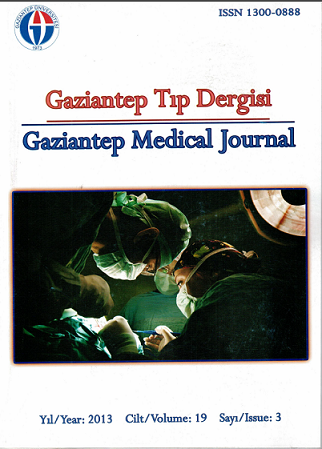Premalignant and malignant changes in endometrial polyps
Endometrial poliplerde premalign ve malign değişiklikler
DOI:
https://doi.org/10.5455/GMJ-30-2013-140Keywords:
Endometrial carcinoma, endometrial polyp, hysteroscopyAbstract
The objective of this study was to evaluate the risk of premalignant and malignant changes in endometrial polyps that were removed entirely by operative hysteroscopy. The study group was comprised of 101 cases of endometrial polyps diagnosed by diagnostic hysteroscopy, transvaginal ultrasonography and saline contrast sonohysterography in our Obstetrics and Gynecology Clinic from January 2010 to July 2012. A retrospective chart review was then performed with the use of medical records. The operative procedure was performed under general anesthesia. The specimens were placed in 10% formaldehyde for histological examination. Clinical characteristics such as age, parity, menopausal status, hypertension (defined as diastolic pressure ≥90 mm Hg and/or systolic pressure ≥140 mm Hg), abnormal uterine bleeding, diabetes (fasting glucose ≥110 mg/dl) were also reported from the medical records. Statistical Analysis was performed by using the SPSS 11.5 statistical software package (SPSS, Chicago, IL, USA). The mean age of the study group was 45 (25-73) years-old. The most common indication for performing operative hysteroscopy was abnormal uterine bleeding 82.2% (n=83). It is worthwhile to note that 3 patients (2.9%) had premalignant and malignant changes of polyps. One patient who was 58 years old had invasive endometrial cancer. None of the clinical variables considered (diabetes mellitus, hypertension, hormone replacement therapy) were statistically related to the histopathological results. Although the prevalence of premalignant and malignant endometrial polyps is very low, the early diagnosis of malignancy is very important. The most common indication was abnormal uterin bleeding for performing operative hysterescopy.
Metrics
References
Schlaen I, Bergeron C, Ferenczy A, Wong P, Naves A. Endometrial polyps: a study of 204 cases. Surg Pathol 1988;1(3):375-82.
DeWaay DJ, Syrop CH, Nygaard IE, Davis WA, Van Voorhis BJ. Natural history of uterine polyps and leiomyomata. Obstet Gynecol 2002;100(1):3-7.
De Vries L, Dijkhuizen F, Mol B, Brölmann H, Moret E, Heintz A. Comparison of transvaginal sonography, saline infusion sonography, and hysteroscopy in premenopausal women with abnormal uterine bleeding. J Clin Ultrasound 2000;28(5):217-23.
Widrich T, Bradley L, Mitchinson A, Collins R. Comparison of saline infused sonography with office hysteroscopy for the evaluation of the endometrium. Am J Obstet Gynecol 1996;174(4):1327-34.
Goldstein SR, Monteagudo A, Popiolek D, Mayberry P, TimorTritsch I. Evaluation of endometrial polyps. Am J Obstet Gynecol 2002;186(4):669-74.
Sherman ME, Mazur MT, Kurman RJ. Benign diseases of the endometrium. In: Kurman RJ, editor. Blaunstein’s pathology of the female genital tract. 3rd ed. New York, Springer, 2002;421-66.
Widrich T, Bradley L, Mitchinson A, Collins R. Comparison of saline infused sonography with office hysteroscopy for the evaluation of the endometrium. Am J Obstet Gynecol 1996;174(4):1327-34.
Caspi B, Appelman Z, Goldchmit R, Ashkenazi M, Haruvy Y, Hagay Z. The bright edge of the endometrial polyp. Ultrasound Obstet Gynecol 2000;15(4):327-30.
Anastasiadis PG, Koutlaki NG, Skaphida PG, Galazios GC, Tsikouras PN, Liberis VA. Endometrial polyps: prevalence, detection, and malignant potential in women with abnormal uterine bleeding. Eur J Gynaecol Oncol 2000;21(2):180-3.
Bakour SH, Khan KS, Gupta JK. The risk of premalignant and malignant pathology in endometrial polyps. Acta Obstet Gynecol Scand 2000;79(4):317-20.
Savelli L, De Iaco P, Santini D, Rosati F, Ghi T, Pignotti E, et al. Histopathologic features and risk factors for benignity, hyperplasia, and cancer in endometrial polyps. Am J Obstet Gynecol 2003;188(4):927-31.
Scott RB. The elusive endometrial polyp. Obstet Gynecol 1953;1(2):212-8.
Wolfe A, Mackles A. Malignant lesions arising from benign endometrial polyps. Obstet Gynecol 1962;20(3):542-50.
Orvieto R, Bar-Hava I, Dicker D, Bar J, Ben-Rafael Z, Neri A. Endometrial polyps during menopause: characterization and significance. Acta Obstet Gynecol Scand 1999;78(10):883-6.
Ben-Arie A, Goldchmit C, Laviv Y, Levy R, Caspi B, Huszar M, et al. The malignant potential of endometrial polyps. Eur J Obstet Gynecol Reprod Biol 2004;115(2):206-10.
Clevenger-Hoeft M, Syrop CH, Stovall DW, Van Voorhis BJ. Sonohysterography in premenopausal women with and without abnormal bleeding. Obstet Gynecol 1999;94(4):516-20.
Tjarks M, Van Voorhis B. Treatment of endometrial polyps. Obstet Gynecol 2000;96(6):886-9.
Giordano G, Gnetti L, Merisio C, Melpignano M. Postmenopausal status, hypertension and obesity as risk factors for malignant transformation in endometrial polyps. Maturitas 2007;56(2):190-7.
Downloads
Published
How to Cite
Issue
Section
License
Copyright (c) 2023 European Journal of Therapeutics

This work is licensed under a Creative Commons Attribution-NonCommercial 4.0 International License.
The content of this journal is licensed under a Creative Commons Attribution-NonCommercial 4.0 International License.


















